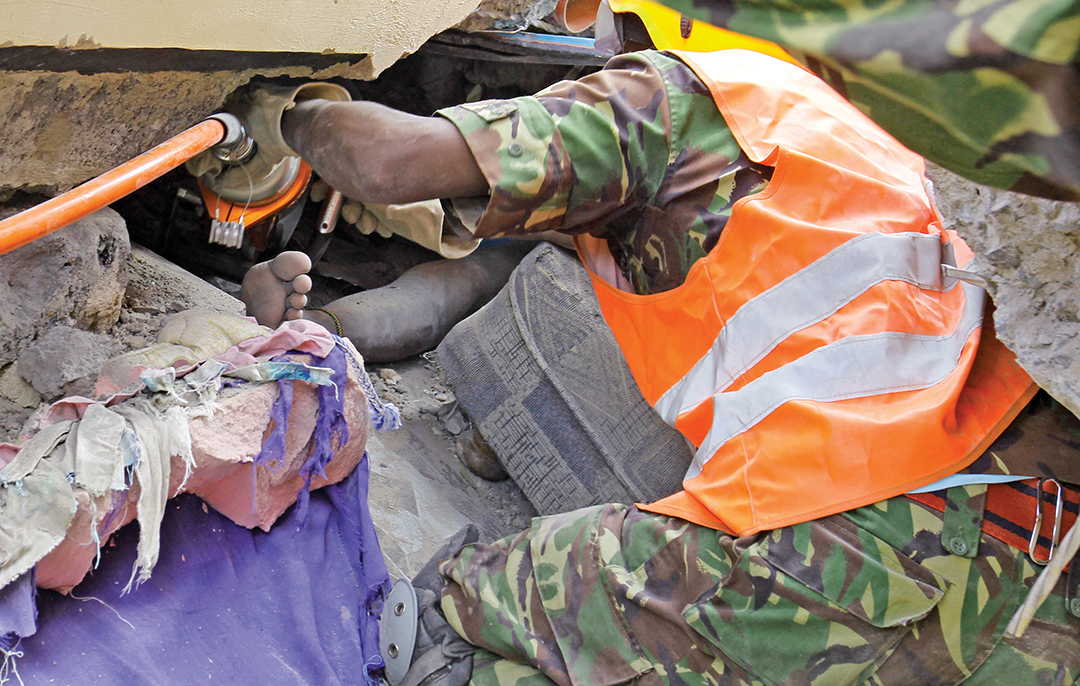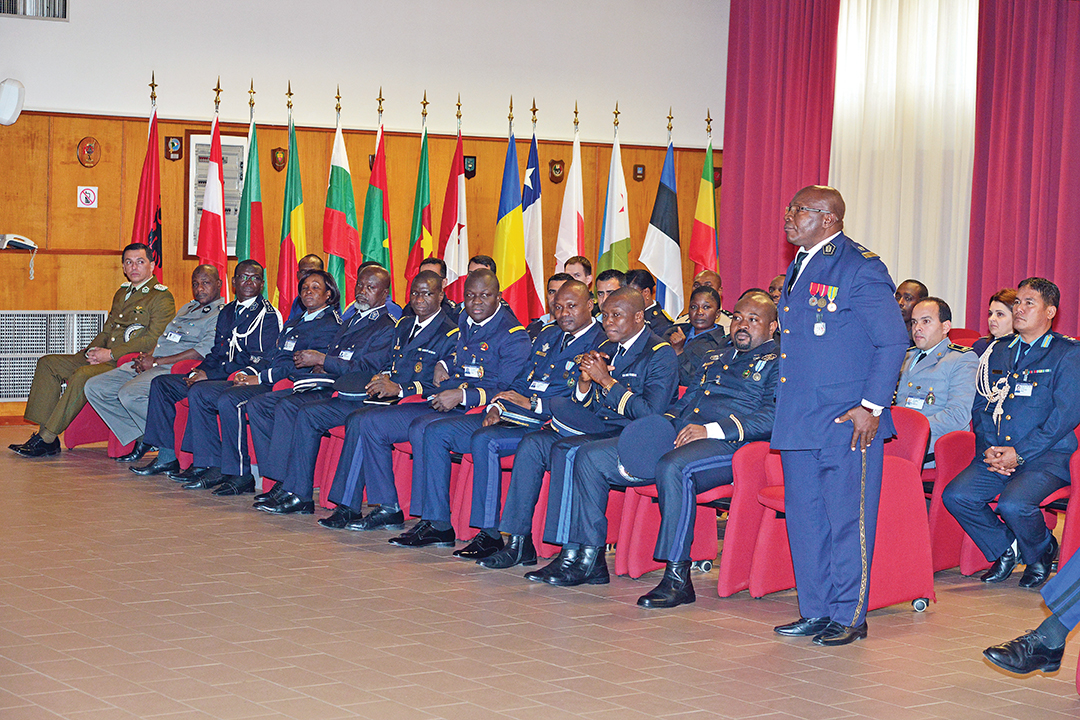Armed Forces Have The Skills And Tools To Respond To Crises
ADF STAFF
or years, when countries needed their armed forces’ help during natural disasters, the philosophy was “last in, first out” — don’t use them except as a last resort, and use them as little as possible. But that thinking is at odds with the need for a timely response, which is something armed forces are trained to do.
The “last resort” thinking, particularly in Africa, has given way to the realization that armies, navies and air forces have a particular set of skills and equipment and can, in fact, be the first line of defense in dealing with disasters. For example:
In Zambia, armyworms began attacking corn crops in late 2016. The country has no national air service, so President Edgar Lungu called on his Air Force to airlift pesticides. The worms, so named because they eat almost any vegetation in their way, had destroyed crops in six of the nation’s 10 provinces as of early 2017. Four years earlier, the worms destroyed corn, cassava, sorghum and rice fields, Reuters reported.

In South Africa, 120 South African Sailors joined firefighters to control wildfires spreading near Cape Town in January 2017. Two South African Air Force helicopters also deployed. The website Africanews reported that the Sailors worked “day and night” to bring the fires under control.
In November 2016, 2,000 troops from Burundi, Kenya, Rwanda, Tanzania and Uganda gathered in Kenya for training on how to conduct rescue missions. The Star of Kenya reported that in addition to the rescue training, the Soldiers were learning how to work together as members of the East African Community. The Soldiers also took on projects designed by Kenyan military engineers, including grading roads, sinking boreholes and rehabilitating schools.
In Uganda, Soldiers crossed over their border into South Sudan in July 2016 to rescue Ugandans and others trapped in the fighting in that country. Over the course of a few days, they used dozens of armored vehicles to rescue an estimated 3,000 Ugandans.
DIFFERENT SET OF RULES
In many ways, armed forces are tailor-made for helping out, or even taking the lead, in rescue operations. The use of a nation’s armed forces can be particularly helpful in remote areas, where civilian infrastructure for handling disasters can be lacking or nonexistent. But using armed forces for rescue operations in Africa, as in other parts of the world, can have its own problems.
During the colonial period, many African countries used their military forces to control the population, not protect them. After independence, African nations began the slow process of military reform to meet the needs of their citizens, and yet, some level of distrust remains. That has been particularly the case in countries that have had multiple government coups and extended periods of military rule.
Jibrin Ibrahim, a writer for Nigeria’s Premium Times, noted, “Military rule ultimately impacts negatively on society by generalizing its authoritarian values, which are in essence anti-social and destructive of politics.”
A South African Army officer told ADF that because of the lingering memories of apartheid, many South African civilians still harbor feelings of distrust and resentment toward their country’s Soldiers, even during rescue missions. He noted that he and his Soldiers have been shown more courtesy and respect in neighboring countries than in their homeland, and he said that more time would have to pass before the bad old days are behind the country.

REUTERS
Even in countries with well-established relationships between civilians and the armed forces, the use of Soldiers and Sailors in times of crisis is under development. In a 2015 study on disaster relief, researcher Vanessa Thevathasan wrote, “It is essential that a greater push for inter-dialogue, collaboration and coordination within the military, humanitarian and state sectors takes place to better define civil-military relations for disaster response.”
Thevathasan pointed out several examples of successful rescue work around the world, including the establishment of isolation and treatment centers in West Africa during the 2014 Ebola outbreak.
“Coordination and communication between the civilian humanitarian sector and the military has historically been extremely challenging to overcome,” she wrote in the study. “Barriers include differences in cultures, priorities and operating modes between military and civilian staff that directly impacts information coordination, which itself contributes to the success or failure of relief operations.”
One notable success, she said, was Japan’s military assistance after the earthquake-tsunami in 2011. “The rapid deployment of troops and engagement with the civilian population created broader public support for defense spending and greater encouragement towards the military’s role in disaster assistance both at home and abroad.”
FAST-MOVING, SELF-CONTAINED
A 2011 study after the earthquake in Japan concluded that for military contributions to be successful in disaster relief, they need to be:
- Self-contained, with little need for additional help that might slow down the response. “This includes making greater use of reservists; reserve personnel tend to have unique specialist skills from civilian careers which are of great value in responding to crises,” the study, written by security consultant David Rubens, concluded.
- Fast-moving and able to deploy in a matter of hours, taking with them all the equipment they will need initially.
- Multiskilled and able to adapt and respond to unanticipated scenarios.
- Self-directing, able to make fast decisions based on their own assessments of situations, and not relying on a distant command chain.

SPC. PAOLO BOVO/U.S. ARMY
There are some established guidelines for militaries when responding to disasters with other organizations. In 2008, the Stockholm International Peace Research Institute listed factors that contribute to a successful military response to a crisis:
Timeliness: If the armed forces are going to be first responders, speed is critical. If military resources are slow to arrive, it can prevent or delay the deployment of alternative civilian services.
The right tools for the job: Deployed people and assets must meet the needs of the situation and be appropriate to the local culture and political environment.
Efficiency: The military assets must be well-managed, and well-integrated with wider international relief efforts.
The “absorptive capacity” of the host country: The country receiving the assistance must be able to accommodate an influx of people and resources. It must also be able to integrate and coordinate the assistance with its own resources. A country capable of using help must also be capable of helping itself.
Coordination of resources: Assistance can come from the armed forces, civilian governments, international organizations and nongovernmental organizations. The groups supplying the help must be able to easily share information. The institute said the groups must achieve a harmony of different cultures.
Officials emphasize that crisis management requires careful planning and information sharing. When an earthquake struck Haiti in 2010, the Haitian government was widely criticized for being slow to respond and poorly prepared. There were plenty of partner nations that wanted to help out, but there was no database of the specific capabilities, training and rescue goods that each country possessed. There was no way for rescue organizers to match up Haiti’s most critical needs, such as food, water and temporary shelter, with the types of help volunteer nations wanted to provide.
Mark Phillips wrote a paper for the British think tank Royal United Services Institute on the role of the military in international disaster relief. He said that disasters are getting “increasingly harsh” and becoming more difficult and hazardous to deal with. Armed forces, he said, “are better suited to operating in a timely way in adverse circumstances compared to most other organizations.”

